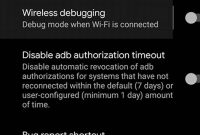If you’re like most people, you probably put off updating your phone software until you absolutely have to. But did you know that keeping your phone software up to date is important for both performance and security? In this article, we’ll show you the easy way to update your phone software. You won’t need any technical expertise – just a little patience and some time to let your phone do its thing.

Why Should You Update Your Phone Software?
It’s easy to ignore software updates on your phone, especially if you’re not experiencing any issues. However, keeping your phone software up to date is important for several reasons.
Security Patches
One of the key reasons to update your phone software is to protect your device from security threats. Hackers are constantly finding new ways to exploit vulnerabilities in software, and phone manufacturers push out regular updates to fix these issues.
Downloading the latest software update ensures that your phone has the latest security patches that protect your personal information from being compromised by malicious third-party apps or hackers.
Bug Fixes
In addition to security patches, phone software updates also fix bugs and glitches that affect your device’s performance. These bugs can cause apps to crash, slow down your phone, and drain your battery life.
By updating your phone software, you can fix these issues and enjoy a smoother, more efficient user experience. This can help you to save time and avoid frustration when using your phone.
New Features
Phone software updates also bring new features to your device. These features can include improvements to your phone’s camera, new emojis, or updates to your phone’s interface.
While these updates may not be essential, they can enhance your phone experience and add new functionality to your device. This can make it easier for you to use your phone and enjoy it more fully.
Improved Performance
Lastly, updating your phone software can help to improve your device’s overall performance. By fixing bugs and improving security, your phone can run more smoothly and efficiently.
You may notice that your phone runs faster, apps open more quickly, and your battery life improves after updating your phone software.
How Do You Check for Software Updates?
Keeping your phone’s software up-to-date is crucial to ensure your device functions smoothly and your data is protected. Here are some ways to check for software updates:
Via settings
The simplest way to check for software updates is to navigate to the ‘settings’ section of your phone. For Android, go to ‘settings,’ then ‘system,’ and click on ‘system updates.’ For iOS, go to ‘settings,’ click on ‘general,’ and then click on ‘software update.’
Manufacturer websites
Another way to check for software updates is to visit the manufacturer’s website, which may provide detailed information on the latest updates available for your device along with instructions on how to install them. For example, for Samsung devices, go to its website, click on ‘support,’ then click on ‘software and downloads,’ and enter your device details to check for available updates.
- Check for software updates in settings section of your phone.
- Visit manufacturer’s website.
What Do You Need to Consider Before Updating?
Updating your phone software is important to ensure that your device functions efficiently and has the latest features and security updates. However, before you begin the process, there are some important factors you need to consider:
1. Available Storage
One of the most important considerations before any software update is the available storage on your device. Large software updates require sufficient space on your device to download and install. Before commencing any update, check the amount of free space on your device and clear unwanted files and apps.
- Remove any unused apps from your device and transfer some of your files, such as music and photos, to your cloud storage.
- You may also consider deleting old text messages, call logs, and emails that you no longer need.
2. Battery Life
Software updates can consume a lot of battery life and may take some time to complete. Therefore, it is important to ensure that your device battery is sufficiently charged or is plugged-in before starting the update. You do not want your device to run out of battery power in the middle of the update.
3. Backup Options
Although rare, software updates may go wrong and result in data loss or device crashes. Therefore, it is essential to backup your device before you initiate any software updates. Losing your data can be frustrating and time-consuming.
There are different backup options available depending on your device:
- iTunes or iCloud: Apple devices have an inbuilt backup service that you can use to back up your data to the cloud or your computer.
- Google Drive or OneDrive: Android and Microsoft devices include cloud backup services that allow you to backup your important files, contacts, and settings.
- External Hard Drive: You may also use an external hard drive to backup your data by connecting it to your device through a USB cable.
Remember that your device may not function properly if you fail to consider these factors before updating.
How Do You Update Your Phone Software?
Keeping your phone software up to date is important for security and performance. Here are step-by-step instructions on how to update your phone software.
Step 1: Back Up Your Data
Before updating your phone software, it is important to back up your data to ensure that you do not lose any important information. You can back up your data either to your cloud storage or to your computer.
Step 2: Check for Software Updates
To check for software updates, go to your phone settings and look for the “Software Update” or “System Update” option. Click on this option and your phone will automatically check for any available updates.
Step 3: Download the Update
Once an update is available, click on the “Download” button to start the downloading process. The downloading time will vary depending on the size of the update and the speed of your internet connection, so be patient.
Step 4: Install the Update
After the download is complete, your phone will prompt you to install the update. Click on the “Install” button and your phone will restart to complete the installation process. This process can take several minutes, so make sure that your phone is fully charged or plugged into power.
By following these simple steps, you can easily update your phone software to keep it running smoothly and up to date.
What Do You Do If There’s a Problem Updating Your Phone Software?
Updating your phone can sometimes be a headache. Software updates can fail or may not install at all in certain circumstances. If you’re experiencing trouble updating your phone software, there are a few things that you can do to try and resolve the issue.
1. Check Your Internet Connection
Most software updates require an internet connection to work. A slow or unstable internet connection can cause updates to fail or take a while to download. If you’re having trouble updating your phone software, make sure that your internet connection is stable and fast enough to support the update.
2. Free Up Storage Space
Updates can sometimes require a significant amount of space on your phone. If your phone is running low on storage, it could cause the update to fail. Try deleting unnecessary apps, photos, and videos to free up some space on your phone before attempting the update again.
3. Restart Your Phone
Restarting your phone before attempting an update can help clear any glitches and software bugs that could be interfering with the update process. After restarting your phone, try updating your software again.
4. Try Updating Your Phone Software Using a Computer
If you’re still having trouble updating your phone software, try using a computer to update your phone. Connect your phone to your computer with a USB cable, open your phone’s software update program on the computer, and follow the prompts to update your phone. Updating your phone software using a computer can sometimes be more successful and faster than updating it over Wi-Fi or cellular data.
5. Perform a Factory Reset
If all else fails, performing a factory reset on your phone could fix the issue. Factory resetting your phone will erase all of your phone’s data and return it to its original factory settings. Before performing a factory reset, make sure that you back up all of your important files and documents to a secure location. Once you have backed up your information, go to your phone’s settings and select “Factory Reset” or “Reset Phone”. Follow the prompts to reset your phone to its original settings.
Note: This should be a last resort option, as it will erase all of your personal data and would require you to set up your phone again from scratch.
When Is the Best Time to Update Your Phone Software?
Updating your phone software is an important task that ensures your phone won’t be vulnerable to potential security threats. But, when is the ideal time to update your phone software? Here are some factors to consider:
The Right Timing for Updating Your Phone Software
The recommended time to update your phone software is during the evening when you’re not working or on a weekend when you have more free time. This way, you won’t be interrupted while you’re doing something important on your phone. The updating process may take some time, so having a good amount of battery life and uninterrupted internet connection is important.
Frequency of Updating Your Phone Software
You should update your phone software as soon as a new update is available. Failing to do so may cause your phone to become more susceptible to viruses, malware, and other security threats. Also, some updates bring new features to your phone and enhance its performance, so it’s always a good idea to update your phone software at the earliest convenience.
Staying Informed about Updates
You can stay informed about updates by setting automatic updates for your phone and enabling push notifications from your phone manufacturer about any new update releases. Also, you can check for updates manually by going to your phone settings and choosing the ‘software update’ option.
By following these best practices, you can keep your phone up-to-date, secure, and functioning at its best.
Frequently Asked Questions
| Questions | Answers |
|---|---|
| How often should I update my phone software? | It is recommended to update your phone software whenever an update is available, preferably as soon as possible. |
| What happens if I don’t update my phone software? | Your phone may experience performance issues and become more vulnerable to security threats. |
| Do I need to back up my phone before updating the software? | It is always recommended to back up your phone before updating the software to avoid losing any important data. |
| Can I update my phone software without connecting to Wi-Fi? | Although it is preferred to update over Wi-Fi, it is possible to update your phone software using mobile data. Keep in mind that this may use a lot of data and could result in additional charges from your mobile service provider. |
| What should I do if I encounter any issues while updating my phone’s software? | If you encounter any issues while updating your phone’s software, it is recommended to contact your phone manufacturer or service provider for further assistance. |
Thanks for Reading!
We hope this article has helped you update your phone software easily and without any issues. Remember, updating your phone software is crucial to ensure its optimal performance and to keep it secure. If you have any questions or concerns, please don’t hesitate to visit us again later for more helpful tips and advice.





